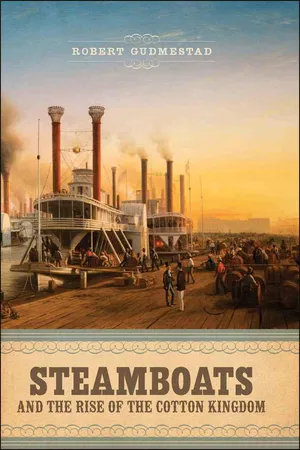
Steamboats and the Rise of the Cotton Kingdom
Race and Class in Modern Society
- 304 pages
- English
- ePUB (mobile friendly)
- Available on iOS & Android
About this book
The arrival of the first steamboat, The New Orleans, in early 1812 touched off an economic revolution in the South. In states west of the Appalachian Mountains, the operation of steamboats quickly grew into a booming business that would lead to new cultural practices and a stronger sectional identity.
In Steamboats and the Rise of the Cotton Kingdom, Robert Gudmestad examines the wide-ranging influence of steamboats on the southern economy. From carrying cash crops to market to contributing to slave productivity, increasing the flexibility of labor, and connecting southerners to overlapping orbits of regional, national, and international markets, steamboats not only benefited slaveholders and northern industries but also affected cotton production.
This technology literally put people into motion, and travelers developed an array of unique cultural practices, from gambling to boat races. Gudmestad also asserts that the intersection of these riverboats and the environment reveals much about sectional identity in antebellum America. As federal funds backed railroad construction instead of efforts to clear waterways for steamboats, southerners looked to coordinate their own economic development, free of national interests.
Steamboats and the Rise of the Cotton Kingdom offers new insights into the remarkable and significant history of transportation and commerce in the prewar South.
Frequently asked questions
- Essential is ideal for learners and professionals who enjoy exploring a wide range of subjects. Access the Essential Library with 800,000+ trusted titles and best-sellers across business, personal growth, and the humanities. Includes unlimited reading time and Standard Read Aloud voice.
- Complete: Perfect for advanced learners and researchers needing full, unrestricted access. Unlock 1.4M+ books across hundreds of subjects, including academic and specialized titles. The Complete Plan also includes advanced features like Premium Read Aloud and Research Assistant.
Please note we cannot support devices running on iOS 13 and Android 7 or earlier. Learn more about using the app.
Information
INDEX
Table of contents
- Cover Page
- Title Page
- Copyright Page
- Dedication
- Contents
- List of Maps and Tables
- Acknowledgments
- Introduction: The New Orleans
- One: Southern Steamboat Entrepreneurs
- Two: Working on Old Man River
- Three: Floating Palaces and High-Pressure Prisons
- Four: Indian Removal
- Five: Speed and Safety
- Six: The Nature of Improvements
- Seven: The Rise of the Cotton Kingdom
- Eight: Steamboats in Decline
- Epilogue: Mark Twain’s Odyssey
- Appendix A: Estimates of Steamboat Construction, Tonnage, and Longevity on Southern Rivers, 1811–1860
- Appendix B: Choctaws, Creeks, Chickasaws, Seminoles, and Cherokees Removed by Steamboat, 1830–1843
- Appendix C: Estimates of Accident Rate, 1811–1851, and Fatality Rate from Boiler Explosions, 1816–1848, for Western Steamboats
- Appendix D: Estimates of Wood Consumption by Southern Steamboats, 1811–1860
- Appendix E: Estimated Costs Associated with Southern Steamboats, 1811–1860 . . . 186
- Appendix F: Estimated Ton-Miles, Passenger Miles, and Tonnage Hauled for Southern Steamboats and Southern Railroads in Selected Years
- Abbreviations
- Notes
- Selected Bibliography
- Index